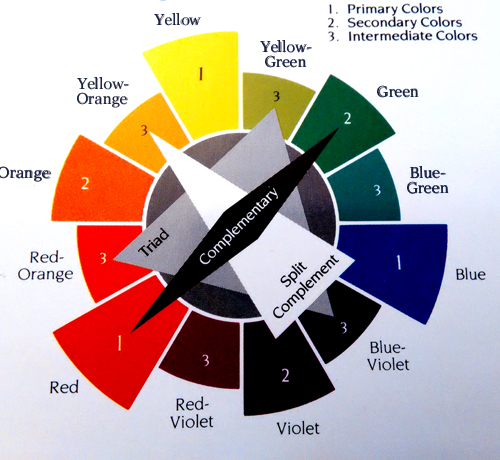The color wheel consists of twelve colors. The three primary are red, yellow and blue. The three secondary are orange, green and violet. The remaining six are known as complementary. And then there is more…Quilt color is of concern to quilters. Beginning quilters and master quilters want a better understanding of how to use the color wheel.
The secondary colors are made by mixing:
- Red and yellow produce orange
- Yellow and red produce violet
- Blue and yellow produce green
These are six hues which are associated with the rainbow; red, orange, yellow, green, blue, and violet. The rainbow contains primary and secondary colors which shine intensely in the sky. It is the intensity of these pigments that capture our attention. Sorry, I have never found a pot of gold at the end of the rainbow, have you?
The complementary hues are opposite of each other on the color wheel. Opposite of yellow is purple, opposite of blue is orange, and opposite of red is green and so on.
The analogous color resides on either side of the secondary. Example. Blue is a secondary. To the right of blue is magenta and purple. If you selected yellow, to the right you will see yellow-green, and green.
You may choose four of these side by side pigments such as yellow-orange, orange, red-orange, and red. They will look beautiful in a quilt because they blend together with each other. They are good like-minded neighbors.
Quilters often talk about selecting light, medium, or dark to add value to the quilt. Artists describe their paints as having a tint or shade which is the value of a color. If you lighten by adding white it becomes a tint. If you add black it becomes darker or shade.
Both the quilter and the artist are saying the same things using different terminology. To clarify add more white to a color and the fabric is light, add a hint of black and the fabric is medium, add more black and the fabric is dark. Now it is not so confusing.
Neutral pigments will include black, white, and gray. These no colors are restful to the eye and are usually used in the background fabric or next to an intense color to cut down on the brilliancy. However, using these neutral pigments can also make a very dramatic or bold quilt design. Black and white makes a bold statement. Black and red is very dramatic.
In addition to black, white, and gray, many quilters also like to use brown, beige, and muslin. Beige, muslin, and medium and lighter shades of brown truly go unnoticed and are great for backgrounds. Dark brown seemingly can create the same dramatic effects as black.
You can choose to make a monochromatic quilt which is sewn with one color. This can be a very dull quilt. This quilt can be made exciting by adding different textures and types of fabrics or varying the dye intensity, value or tone.
Warm colors are located on the right side of the wheel and make you feel warm and cuddly or stimulated into action. These are the reds through yellows. Cool colors located on the left side of the wheel are calming or peaceful and range from green to purple.
The Author:
Visit the website of Tricia Deed https://www.triciadeed.com. for more hobby interests. Additional recreation and leisure activities articles will be found.
